The Jacobean holy year is a key event of the Jacobean traditions. Pilgrims await it with impatience and it’s always celebrated in pomp and circumstance!
But why, how? This post tells you everything about it!
In this post:
Jacobean holy year in a nutshell
Ok. But really, what is a “holy year”?
A short history
Celebrations on schedule
Catholic traditions
Non-religious perspectives
Holy years and the Camino
Holy years… away from Santiago!
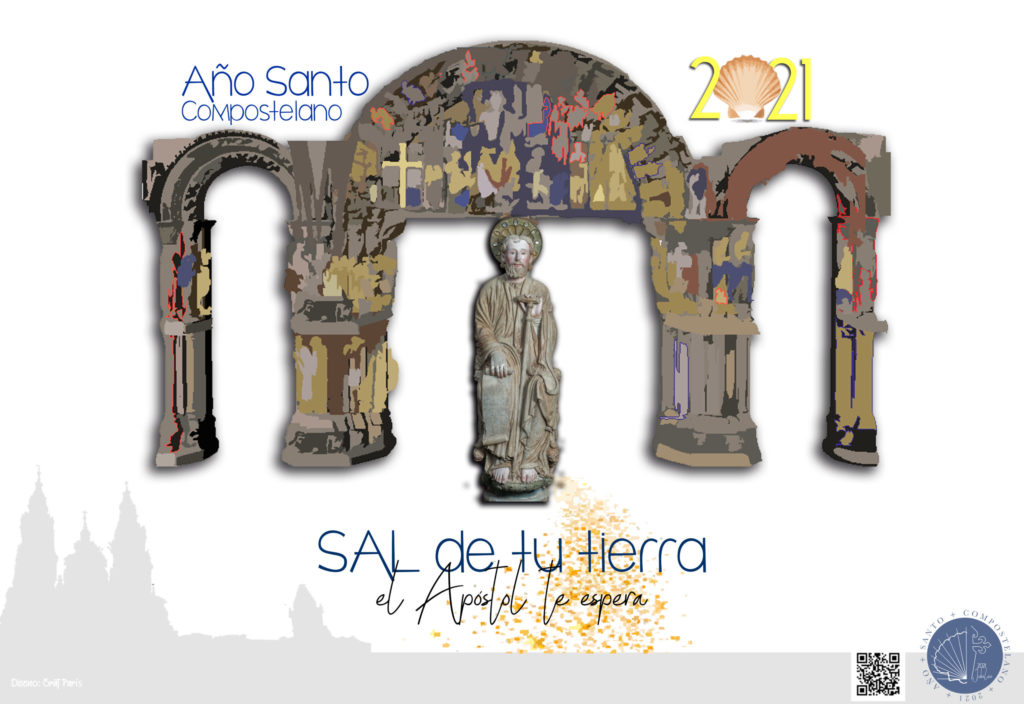
Jacobean holy year in a nutshell
Just like the pilgrimage to Santiago, the Jacobean holy year as a religious origin. It’s an extraordinary Catholic celebration, fully dedicated to Saint James the Great.
The Christian Calendar of saints celebrates Saint James on Jul 25 of each year. In ordinary years, this celebration is… ordinary! When this date falls on a Sunday however, this day and the whole year become a special event: it’s a holy year!
The event is especially meaningful for Catholics but, over the past decades, holy years have become a non-religious celebration too. Everyone celebrates them nowadays, believers and non-believers alike!
The heart of the celebrations take place in the Galician city of Santiago de Compostela but the event is also celebrated across Spain, whose patron saint is Saint James.
Thanks to the influence of the cult to Saint James and his pilgrimage, the Jacobean holy years aren’t just limited to Santiago, or even to Spain! They are celebrated all along the Caminos and even outside of Europe…
Ok. But really, what is a “holy year”?
Well indeed… Even with this short presentation you still don’t know exactly what holy years are! Let’s get into more details about them and what they mean. And yes, “them”, because there are several types of holy years!
Holy years, definitions
Also called Jubilee
For the Roman Catholic Church, a holy year (or jubilee year), is a special time of remission during which sins are forgiven. Inspired by Jewish traditions, it is an invitation for all believers to reaffirm their faith, strengthen their spiritual practices and perform various rituals to be granted special graces called plenary indulgences. (Called what? We’ll see that in a bit 😉 )
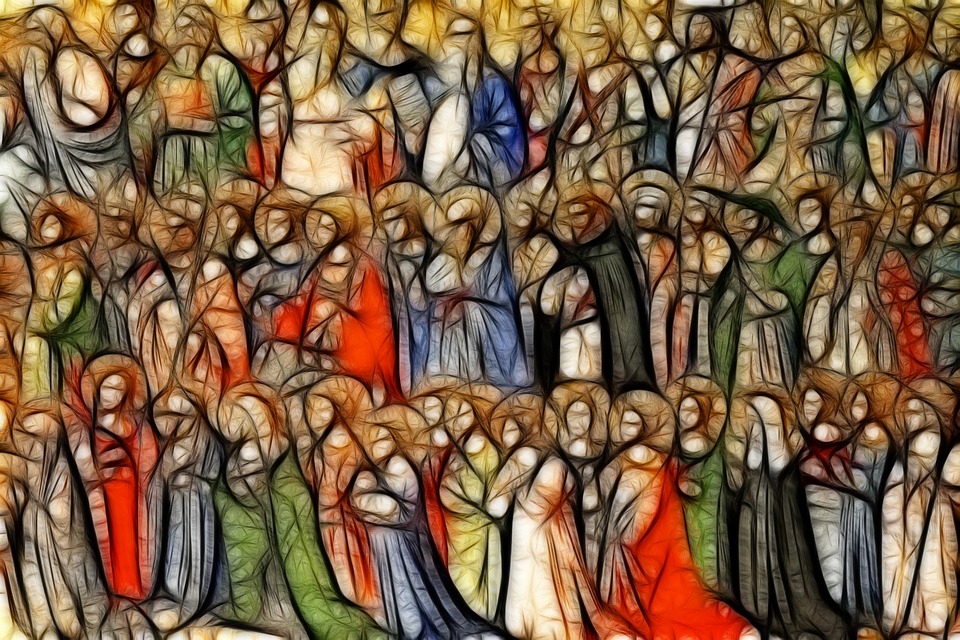
For now, note that there are several types of holy years:
🕊️ Regular holy years, the first one that came to be. They are celebrated in Rome since the year 1300 and happen… regularly (surprising!), every 25 years. The last one was the Great Jubilee of 2000, the next one will be in 2025.
🕊️ Extraordinary holy years are decided and proclaimed by the popes to celebrate a special occasion. They are traditionally held in Rome. The last to date was the extraordinary Jubilee of Mercy, announced by pope Francis for 2016 (and, exception to the rule, the event took place all around the globe, including in Santiago!)
🕊️ Holy years in perpetuum (in perpetuity): those are the ones we’re interested in! They are tied to specific places that received an “eternal” authorization from the pope to celebrate “their” holy year regularly.
Indulgences and plenary indulgences, definitions
For the Roman Catholic Church (again!), an indulgence is a practice related to the doctrine of the forgiveness of sins.
According to this teaching, a sin has an effect that is both spiritual (on the soul) and temporal (worldly). To be fully forgiven, sinners need to cleanse both of those planes. The Sacrament of Confession allows sins to be forgiven on the spiritual plane; indulgences allow sins to be forgiven on the temporal plane.
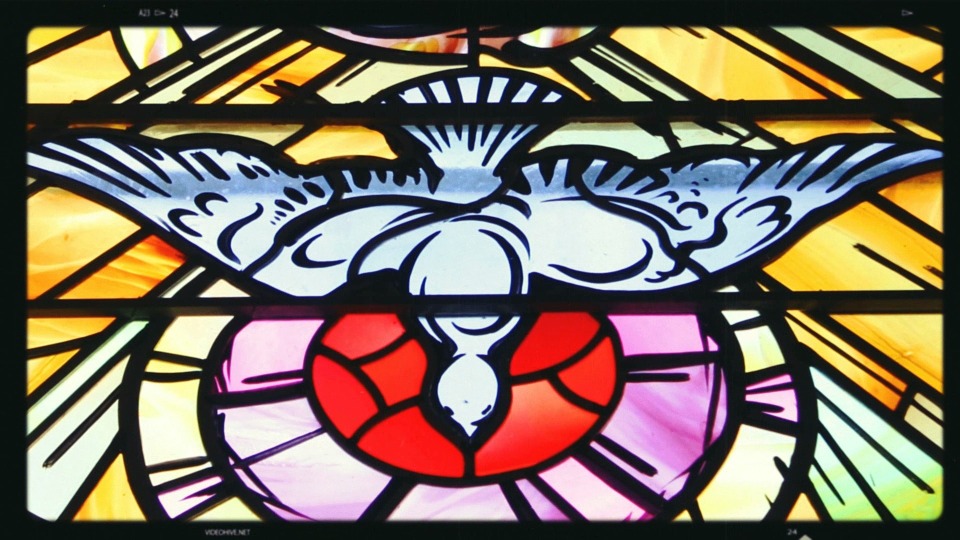
In practice, an indulgence is “a piece” of forgiveness one gains in exchange for an act of devotion (prayer, reading the Bible, pilgrimage, blessing, etc). The ritual is not chosen by the sinner but by a qualified representative of the Church. Several rituals can be prescribed to gain one indulgence.
An indulgence can be partial, if it erases the sin partially; or plenary if it erases it completely. Holy years allow believers to receive a plenary indulgence after completion of specific rituals. It’s not the only way to gain such an indulgence but it’s the one we’re interested in here.
Jacobean Holy Years
The Jacobean holy year has many names. It can be called a Jacobean year or a Jacobean Jubilee year.
In Spanish, they are called Año Santo, Año Jacobeo, Año Santo Jacobeo, Año Jubilar Jacobeo or Jubileo Jacobeo
In Galicia, you will almost exclusively see its Galician version: Ano Santo Xacobeo, Ano Xacobeo or Xubileo Xacobeo.
Thanks to the definitions we just discussed, we are now prepared to understand what a “holy year” really means!
The Jacobean holy year is a holy year in perpetuum tied to Saint James and its sanctuary, that allows believers to gain a plenary indulgence if they complete some rituals. The importance of the Jacobean cult in Santiago and in Spain (and across Europe as well!) led the popes to grant the Church of Santiago to celebrate “its own” holy year, regularly and for all eternity.
So! Let’s get into the details of those years that are so exceptional for Santiago, the Camino… and pilgrims!
A short history of the holy years
The history of the sanctuary is pretty epic, full of tricks and surprising arrangements… The origins of the Jacobean holy years is no exception! There’s no time to get into too much details, but let’s still have a quick look at History.
Some unknown and convenient origins
It’s a fact, we don’t know exactly when the first holy year took place.
Never mind that! The Middle-Age naturally* doctors us “proves” of their legitimacy!
The papal bull Regis Aeterni issued in 1179 by Alexander III names Callixtus II** as the one who initiated the first holy years, thereby dating them around 1120. The text officially concedes Santiago the privilege to celebrate its jubilee and to grant plenary indulgences, just like the Roman jubilee… who only came to be in 1300!
For a long time already, historians have thus come to agree that this bull is an anonymous* fake, written sometime between the mid-14th and beginning of the 16th centuries. No offense to media and institutions that continue to quote this document as the primary source of the Jacobean jubilees; among which… the archdiocese of Santiago!
(*) In the Middle Ages, dating a document to an earlier time and/or signing it in the name of an important person is a common practice. It was done to increase the prestige of the document
(**) Callixtus II, pope from 1119 to 1124 and key actor in the early rise of Santiago’s sanctuary
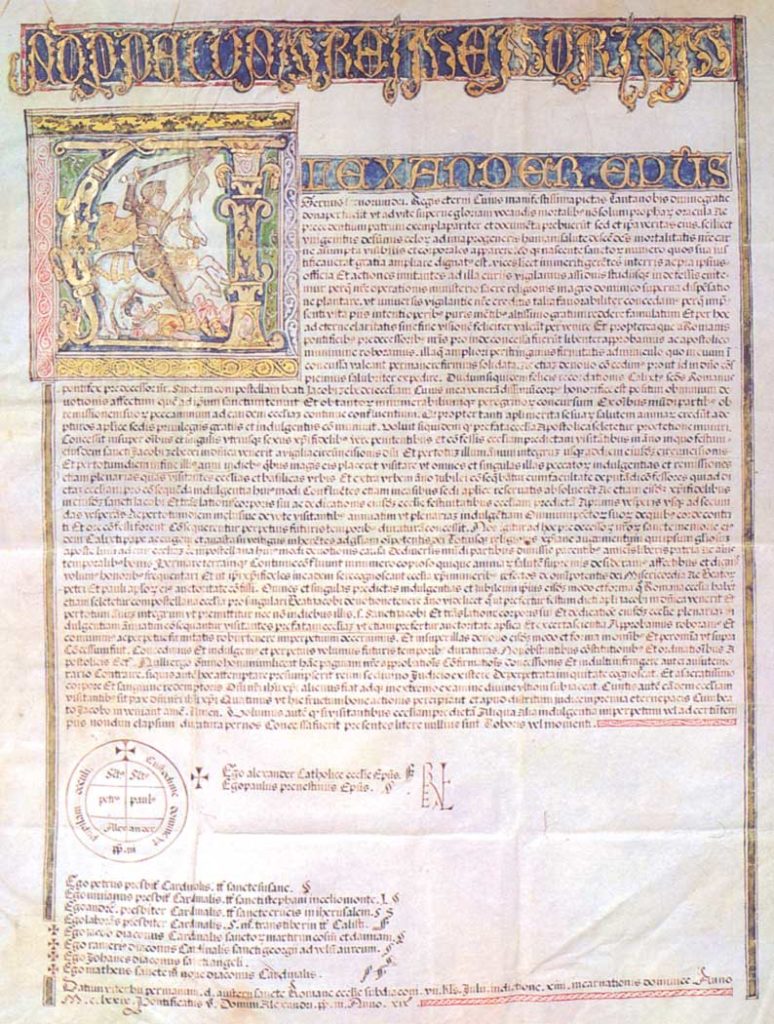
Another theory by some historians suggest 1322 as the date of the first jubilee.
That year and after 4 years fighting against Galician aristocracy who rejected him, Santiago’s archbishop Berengar of Landorra finally settles in the city. He celebrates his first Solemn Mass and decide that Saint Jame’s Day “will be good for everyone”…
Rise and fall
The first documented reference to a Jacobean holy year dates back to 1434, although various historical documents hint that exceptional liturgical celebrations where held in Santiago before. That year anyways, King John II of Castile decreed a safe conduct for pilgrims coming from beyond the Pyrenees, to allow them to safely complete their pilgrimages to Santiago and gain their indulgences.
Jacobean holy years continue to be celebrated and are mentioned here and there during the following year. They are popular all long the 15th and 16th centuries. The various social and ideological upheavals of those times have little effect on the popularity of the sanctuary… even less so on holy years! The jubilee of 1665 is sometimes described as the height of the pilgrimage to Santiago.
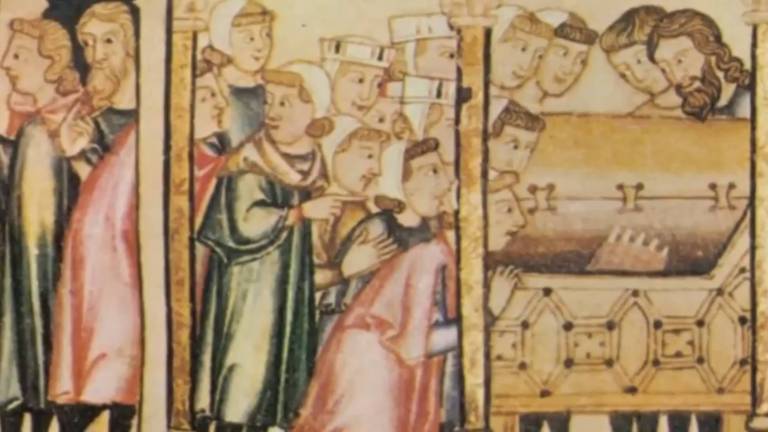
(a perfect picture for my paragraph… but depicting Rocamadour, a French sanctuary associated with the French Camino of Le Puy! 😉 )
Nothing lasts though… Santiago starts its fall from the mid-17th century and continues its descent all along the 18th century. The practice of pilgrimage slowly declines while pilgrims are less and less well-though-of across Europe. In spite of that, Jacobean pilgrimages continue to have some success during that period of time…
The 19th century brought the final blow to Santiago: pilgrims are rare, the sanctuary has fallen into disuse… The jubilee of 1813 shows evidence of the pilgrimage’s standstill at the time, with no pilgrim registered that year!
Rebirth
In this gloomy context, the end of the 19th century brings along quite a turn of events.
In 1879, Saint James’ relics (lost in the 16th century) are found following excavations in the cathedral. Once authenticated, pope Leon XIII confirmed the discovery with the papal bull Deus Omnipotent, published in 1884. It officially recognizes the Jacobean tradition and cult in Galicia and declares an exceptional jubilee in 1885 to celebrate the event.
The bull doesn’t have an immediate effect but from this moment on, the revival of the sanctuary is underway. Santiago slowly rises again over the next decades, starting in Spain. 1909 is a noticeable holy year: Alfonso XIII becomes the first Spanish king to visit the sanctuary in person and pay tribute to Saint James.
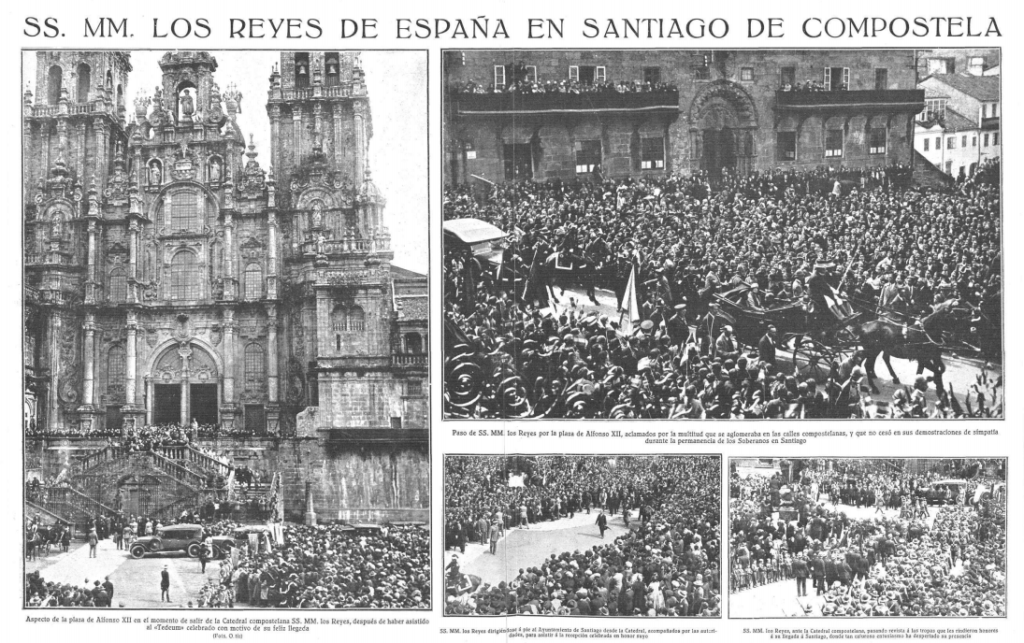
(another perfect picture… although your sharp eyes noticed it of course: 1927 isn’t a holy year! 😉 )
Another noticeable holy years: 1937, extended by the extraordinary jubilee of 1938 by pope Pius XI because of the Spanish civil war. Those 2 holy years are widely used by the Nationalists to serve their interests but major modern Jacobean tradition are also (re)introduced in Spain. Santiago becomes once again the country’s patron saint, his “national offering” is reinstated, July 25 becomes a national holiday.
We need to wait for the second half of the 20th century for the pilgrimage to become an international event, helped by the reopening of Spain’s border. People’s passion for the pilgrimage keeps growing, helped in parts by the increasing efforts put into the advertisement of those holy years.
The jubilee of 1982 is another milestone in the sanctuary’s revival. Pope John Paul II visits the city as a pilgrim and calls Europe to come to Santiago. The Camino also gains one of its most famous symbols, with the first yellow arrows marking the way…
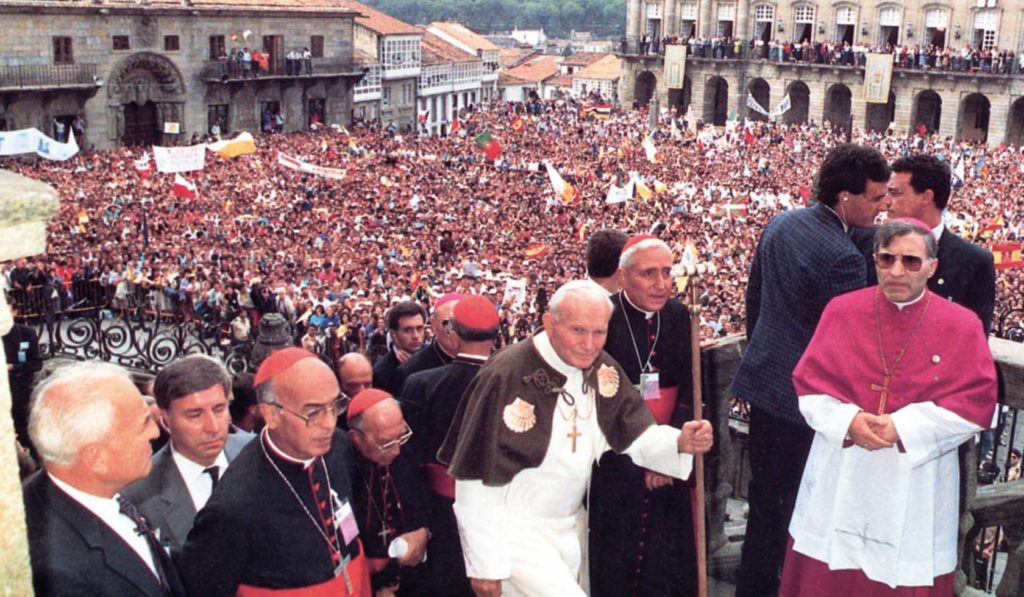
A new golden era
From the 1990s and on, Santiago is only growing in fame and popularity. The holy year of 1993 is the first of a series of jubilees, each more successful and with a greater international influence than the previous one.
The pilgrimage to Santiago becomes organized and looks more and more like the one we know today. The amount of pilgrims grows exponentially, with greater numbers registered during the holy years.

Photo: Alquiler de Coches in Flickr
11 long years pass after the Jubilee of 2010… What a long time to wait! The Jacobean community awaited 2021 to celebrate that holy year in pomp and circumstance and the expectation to break new records with a great number of pilgrims coming from the whole world. Everything and everyone was about ready when surprise, surprise! An undesirable guest crashed the party…
2021, a “failed” jubilee due to the pandemic. But the reason for a new exceptional extension of a holy year, granted by pope Francis: otherwise a normal year, 2022 has become a Jacobean holy year as well!
The next Jacobean jubilee will be 2027… history is still to be written!
Celebrations on schedule
Holy years happen when July 25, Saint James’ Day, falls a Sunday. Our calender is cyclic, making it possible to calculate which years were/will be Jacobean years.
The 25th of July is a Sunday 4 times per periods of 28 years and are celebrated every 6, 5, 6 and 11 years.
Here are the Jacobean holy years of the 20th and 21st centuries:
20th: 1909, 1915, 1920, 1926, 1937-1938, 1943, 1948, 1954, 1965, 1971, 1976, 1982, 1993, 1999
21st: 2004, 2010, 2021-2022, 2027, 2032, 2038, 2049, 2055, 2060, 2066, 2077, 2083, 2088, 2094
The exceptional holy years are underlined; the next ones to come are in gray
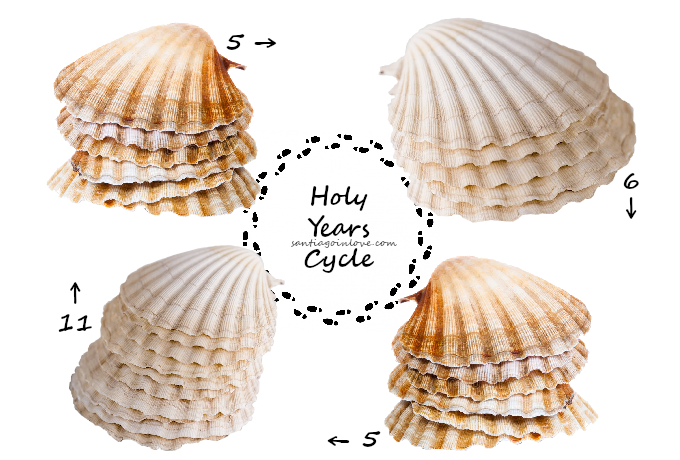
Catholic traditions
Holy years are rooted in the Catholic faith and traditions and remain essentially a religious celebration until today.
Organization, communication
No way to let anything to chance: the archdiocese of Santiago prepares the event a long time in advance. Let’s see what happened for the holy year of 2021.
Website
A website was created: Año Santo Compostelano. It gathers all the information related to the holy year. Agenda, news, testimonies, useful info… everything’s there, and in several languages!
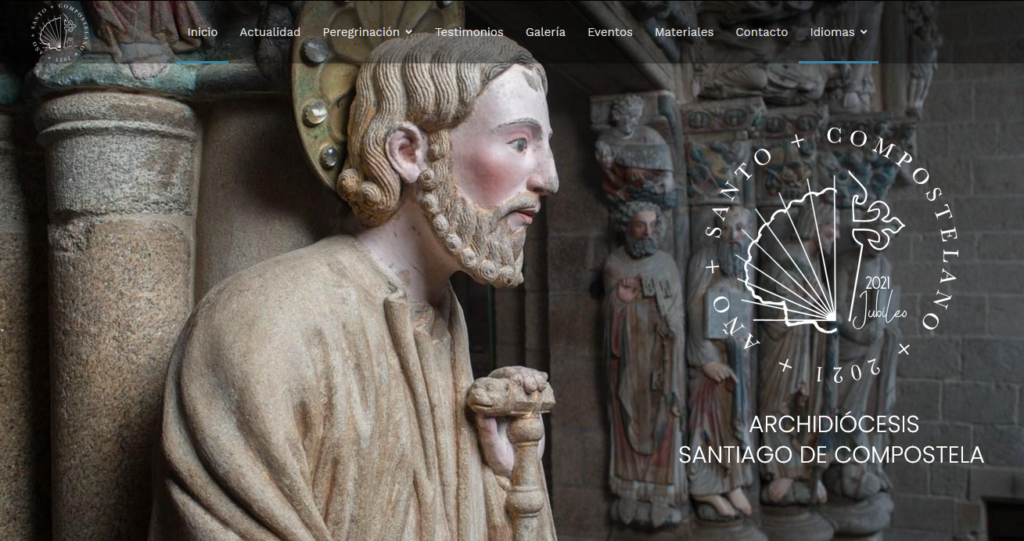
Pastoral letters
Santiago’s archbishop Mgr. Julián Barrio shared a pastoral letter to call believers to celebrate the jubilee and to encourage them to go on a pilgrimage to the sanctuary. Considering how things turned out in 2020, it was completed by an appendix to help pilgrims to be patient…
Motto, logo and poster
The jubilee has its motto, Sae da túa terra. O Apóstolo espérate (or in Spanish: Sal de tu tierra, el Apostol te espera; Leave your Land. The Apostle awaits you)
It also has its logo, each part of it having a specific meaning. It’s blue and white, made by the outlines of a half scallop with radiation lines within and half a cross of Santiago with the mention Xacobeo 2021 on its side. The whole creates a medallion, surrounded by another mention, Ano santo composteláno 2021.
Finally, the holy year also has its poster. It represents the Gate of Glory that has just been renovated, as well as the motto and logo of the jubilee. The design is used on the memorial credential, created for the jubilee.
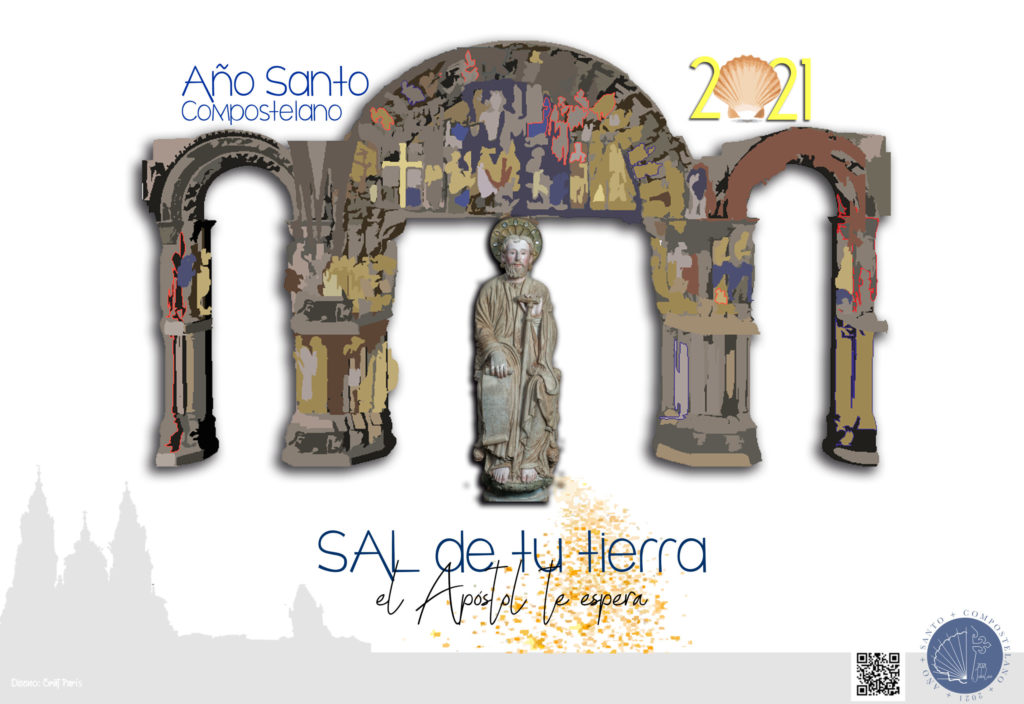
Opening of the holy years
They are opened at the Santiago cathedral on the 31st of December of the previous year, at a ceremony that gathers members of the Church, of the governments and of important people but also some pilgrims and believers.
The ceremony starts with a civil ceremony: the reception of dignitaries who will attend the opening and a military inspection at the Obradoiro square. They then enter the cathedral and join the clergy to get ready to start the liturgical part of the ceremony.
The whole procession goes to the Quintana square. After the reception, some speeches and readings from the Bible, the archbishop open the holy door and enter the cathedral, followed by the procession. The ceremony then continues and ends by a High Mass that includes the botafumeiro.
Check this page to relive the opening ceremony of the holy year of 2021!
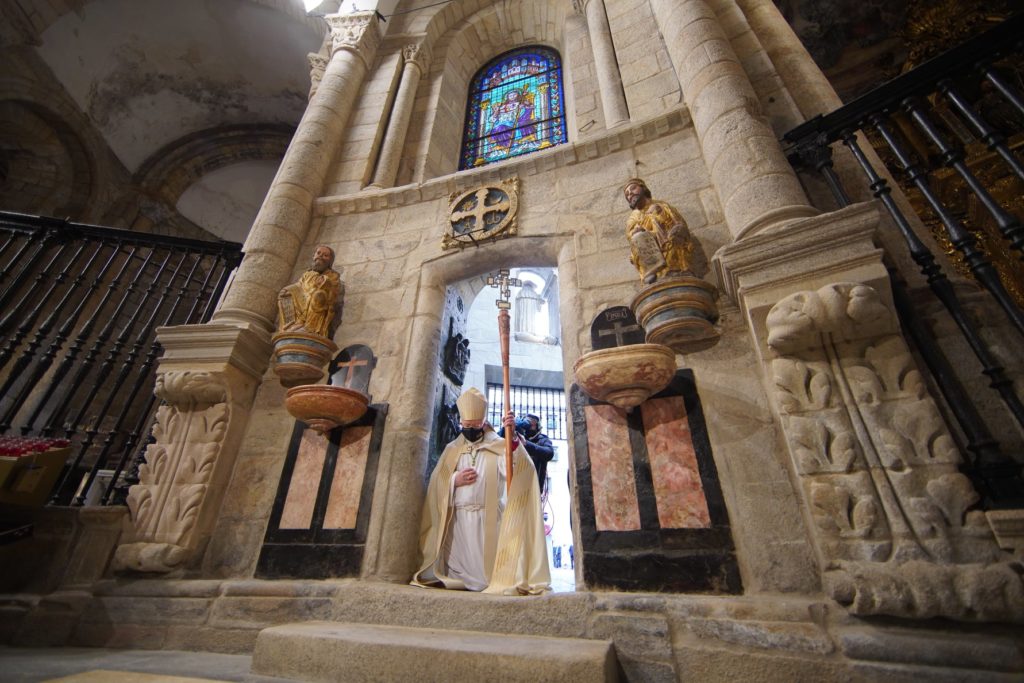
Opening of the holy door
It’s the highlight of the opening ceremony of the jubilee! It’s defined by a whole protocol:
- With a silver hammer that was made for the occasion, the archbishop knocks at the closed door 3 times*. In between each knock, he declaims a liturgical text
- The archbishop then gets the key to unlock the door, then open each panel one after another. Here again, a liturgical text separates each action
- Leaving the door open, the archbishop goes back to the Quintana square to announce the event to the world.
The Berenguela tower lights up, like a lighthouse guiding pilgrims to Saint James - Before the archbishop and the procession enter the cathedral, the holy door is cleansed with olive branches and blessed with holy water
Believers bring an offering of flowers - The archbishop walks back towards the door, kneels in the doorway for a moment for a moment of prayer before entering the cathedral. He places himself by the door to welcome the rest of the procession as it enters the cathedral in his wake
- Once the procession has completely entered the cathedral, the archbishop brings up the rear and walks to the choir to celebrate a High Mass, which includes the botafumeiro
(*) Until 2010, a fragile wall of stones was built in the doorway for the occasion. The 3 knocks with the hammer allowed to destroy it and symbolically (and practically!) open the holy year. This ritual was left out in 2021 to preserve the cathedral as its renovation work was just barely completed.
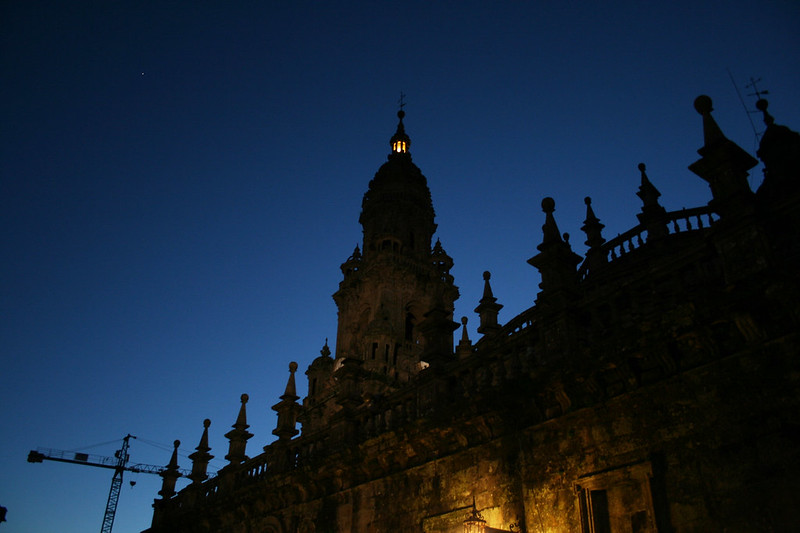
Photo: Contando Estrelas, Flickr
All year long: gaining the jubilee and the plenary indulgences
Here it is, the Jacobean year has started! You only have to comply with specific rituals to gain your jubilee indulgences! 😉
Well, let’s state it right away: it has absolutely nothing to do with the Camino! Indeed, there’s no need to be a Camino pilgrims to gain the plenary indulgences. The means of transport you use to get to Santiago has no importance whatsoever. This also means, there’s no requirement either to get a Compostela. Like the cathedral puts it: you can gain your jubilee indulgences without a Compostela and you can get a Compostela but not gain the indulgences!
So, what do you have to do do receive your indulgences? No more no less than the following rituals!
- visit Saint James’ sanctuary in the cathedral and say a prayer
- receive the Sacrament of Confession, at the cathedral or another place, 15 days before or after your visit
- receive communion during a Mass
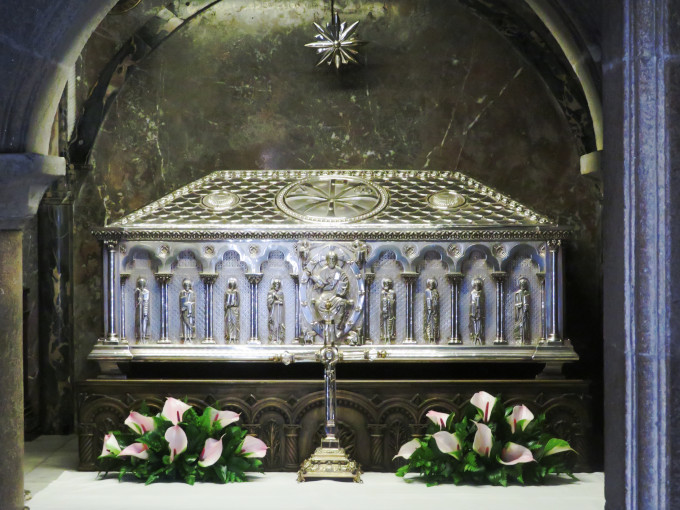
Photo: Marion, Santiago in Love, CC BY-NC-SA
Those rituals can be done in the name of a deceased person; you can only gain a single indulgence per day.
Note that in order to gain your jubilee indulgences, there’s no need for you either to enter the cathedral through the holy door, or to do the abrazo a Santiago, or to see the botafumeiro…
The holy door
We talked about it a lot already! It’s only normal, as it represents the Jacobean holy years almost by itself. As such, it well deserves we take a closer look at it!
Doors have always had a high symbolic significance in many human cultures and traditions. It generally represents a transition between 2 states, 2 conditions or 2 different worlds. Christianity is no exception: it also takes and uses this symbolic meaning as its own, as a crossing point towards salvation and eternal life.
Quite naturally, holy doors are therefore an integral part of the Catholic jubilees. They are always secondary doors, thus representing the ideals of humility and penance, both deemed necessary to achieve salvation. They allow a worldly depiction of the spiritual opening and closure of those extraordinary years. For who walk through them, they symbolize the passage from a state of sin to a state of Grace, hence their other name of “Doors of Forgiveness“.
The holy door of the Santiago cathedral are at the back of the cathedral and only open for the jubilees. You can access it from the Quintana square, first going through a portal topped by sculptures of Saint James and his followers, then through an open-air, short and narrow corridor.
The current door was installed at the end of 2003 for the holy year of 2004 and depicts key moments of the life of Saint James. It allows you to enter the cathedral by the ambulatory behind the choir, with an almost-direct access to the apostle’s relics.
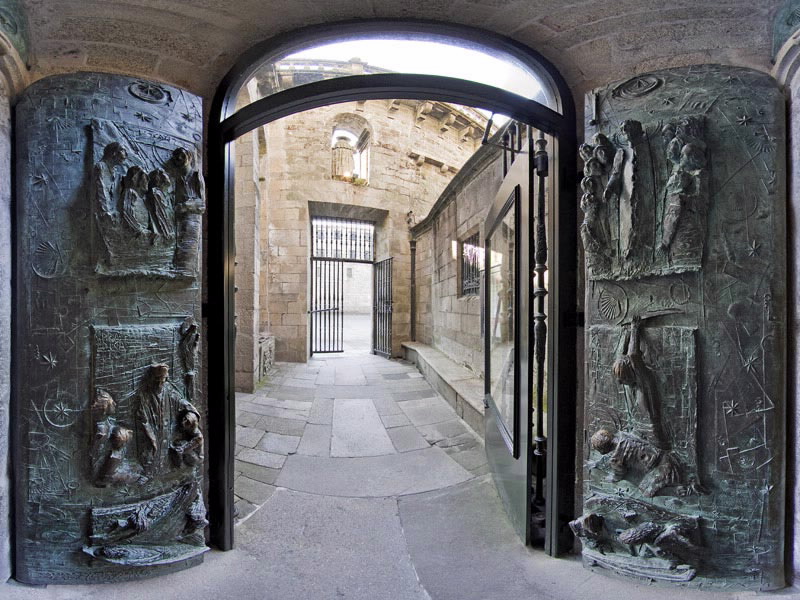
Photo: caminodesantiago.gal
Whether you’re a believer or not, walking through the holy door is a special, even moving experience for pilgrims, who sometimes arrive in Santiago from a very long distance. It’s also a very popular ritual, as demonstrated by the long waiting lines that can stretch a long way, sometimes far outside the Quintana square!
Many people don’t hesitate to wait in line for hours under the rain or in the blazing sun to be able to walk through that door…
Solemnity of the Apostle Saint James
Saint James’ Day, on July 25th, is the highlight of the holy year. Because Saint James is Santiago’ patron saint, the Solemnity of the Apostle are held every year (just like other patronal feasts across Spain, like the famous ones in Pamplona). They are made of an ensemble of liturgical rites that start way before July 25th.
For the jubilees, those celebrations are more sumptuous than for regular years.
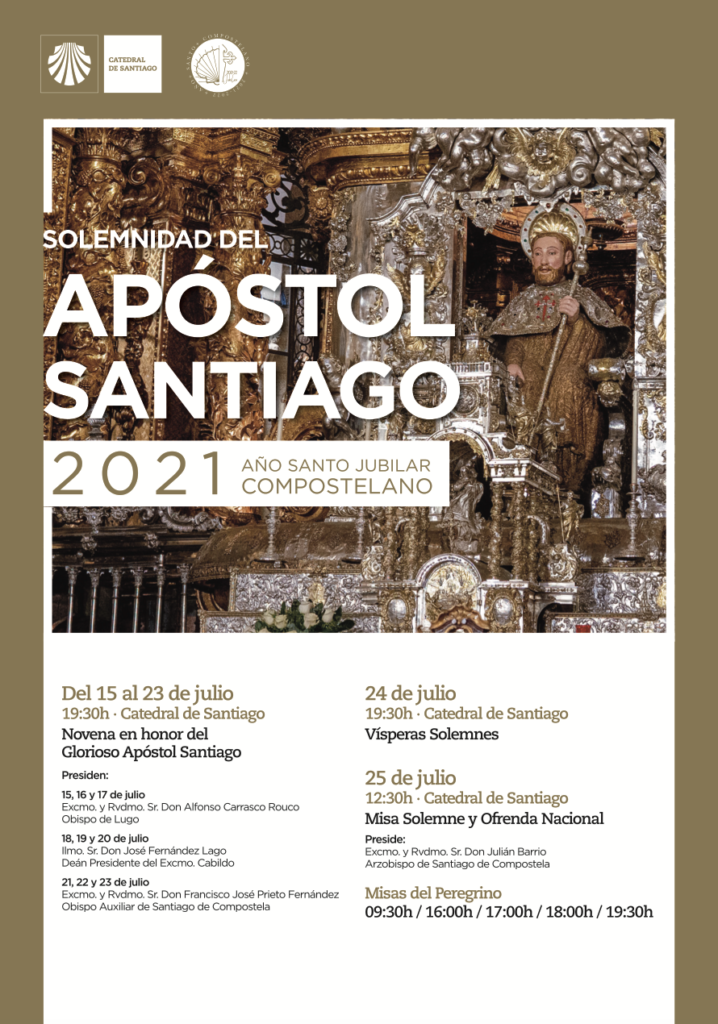
Source: Catedral de Santiago
The Solemnity opens more than a week before Saint James’ Day with a novena, a series of Masses dedicated to Santiago, one every day during 9 days. A High Mass is also celebrated on the eve of Saint James’ Day.
On Sundays, celebrations are at their peak. Many important people come to Santiago for the occasion, including high-ranked members of the clergy and the Spanish royal family. They meet at the Obradoiro Square, where they are greeted according to protocol before entering the cathedral.
A Solemn Pontifical Mass (with use of the botafumeiro) is celebrated, during which the King pays the Voto de Santiago, the traditional offering to Saint James in the name of the people of Spain.
Religious influence
There’s no doubt that the Jacobean years are an opportunity for the sanctuary to preserve and extend its influence across the globe and particularly, across the Christian community.
The presence of the pope in Santiago for a holy is neither a requirement nor a tradition. However, the last popes had a great influence on the rebirth of the sanctuary, including through the holy years. We talk about them when we discussed the history of the jubilees, but let’s mention again Leon XIII and Pius XI, who respectively proclaimed the exceptional holy years of 1885 and 1938. John Paul II, first pope to visit Santiago fo a holy year (1982); followed by Benedict XVI in 2010.
As for Francis, he has been invited to join the celebration of the jubilees of 2021 and 2022 but has not given any answer yet. He has however already become a part of the Jacobean holy years’ history by granting Santiago the exceptional extension of the jubilee to 2022.
Of course, the recognition of the sanctuary by the Vatican or the presence of the pope in Santiago for a holy year confirm the legitimacy and the importance of Santiago within the Catholic Church and community!
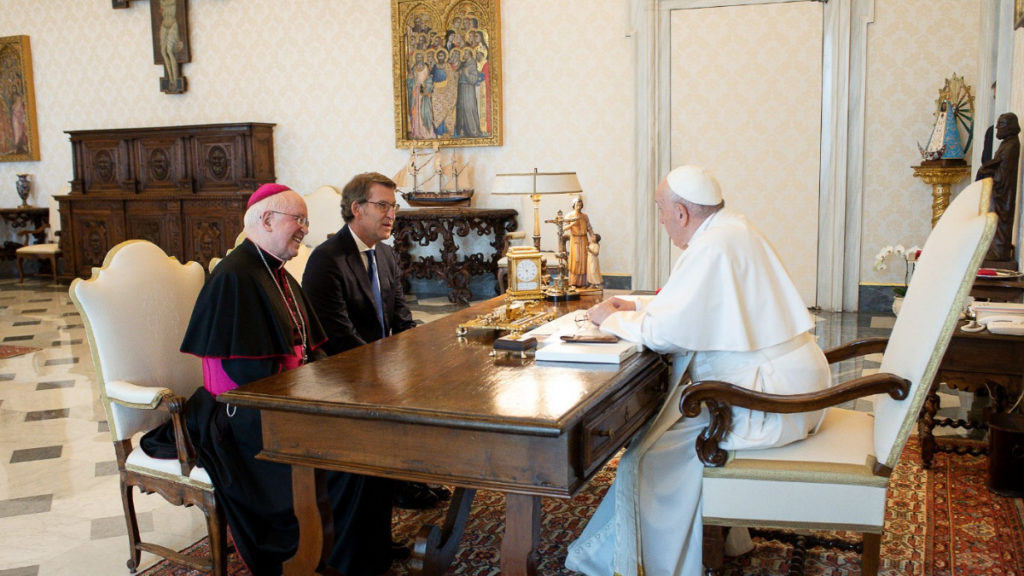
Photo: Info Vaticana
Beside those high-circle events, large celebrations are planned for the believers.
The European Youth Pilgrimage takes place in Santiago when there’s a Jacobean holy year. The gathering planned in 2021 was cancelled because of Covid and rescheduled in 2022 thank to the extension of the jubilee.
Many other pilgrimages are also organized by various local Catholic communities.
Closure of the holy year (and door)
The Jacobean jubilees are concluded on the 31st of December, with a official ceremony that is very similar to the opening one.
It starts the same ways, with a civilian ceremony on the Obradoiro Square (greeting of dignitaries and military inspection) and the entry in the cathedral. The liturgical ceremony is kind of the opposite of the opening ceremony.
The procession, with the archbishop at the rear, goes out of the cathedral through the holy door and on to the Quintana Square. A short ceremony follows, before the archbishop goes back to the door. He kneels for a moment of prayer, then rise to lock the door that will remain sealed until the next jubilee.
The ceremony moves once more into the cathedral, for a High Mass (with botafumeiro) that concludes the holy year.
A non-religious event too!
Religious celebration have always coexisted with popular celebrations: the Jacobean holy years are no exception! Those jubilees always bring up some non-religious excitement.
This phenomenon is more and more obvious with each new holy year of the past decade. The rebirth of the sanctuary and the fast-growing Camino offered more and more opportunities for everyone (governments, associations, businesses, etc) and translated into larger and larger popular celebrations.
Organization, communication
Spain has a national public body that is all about Jacobeans matters: the Consejo Jacobeo (Jacobean Council). It takes care of the coordination of projects and events related to the Camino, between the State and the regions. They also play a great part the organization of the non-religious aspects of the holy years.
For example, it’s responsible for the official national website of the jubilee and the various logos for the holy years 2021-2022.

Each region also has its own body dedicated to the Jacobeans matter, to design its own advertisement and agenda.
Galicia may of course be the best example… As home of Saint James’ relics and many Caminos, the region is particularly active when it comes to promoting the pilgrimage. It also has its own website, events, advertisement and at times, its own logo. You probably have met Pelegrin on your Camino, this funny-looking mascot created by Galicia for the holy year of 1993!
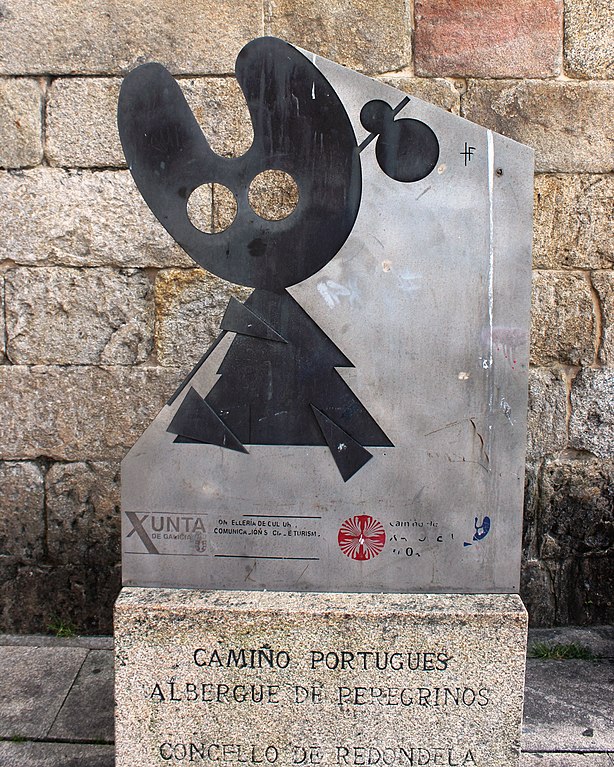
Photo: Tommyhilfiger, CC BY-SA
Festas do Apostolo
The Festival of the Apostle is the non-religious counterpart of Santiago’s patronal feast and the largest celebration in Galicia. Just like the Solemnity of the Apostle, they take place every year. They are held during the second half of July and last for 2 weeks.
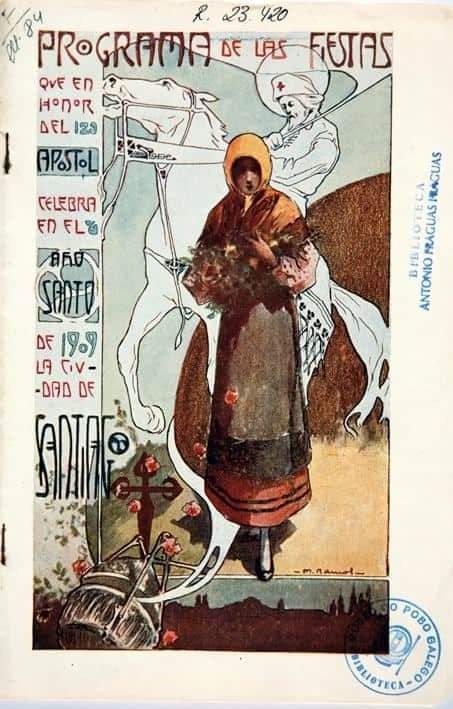
The program of the festival during the holy years isn’t really different from regular years, apart for the opportunity it offers to plan for more exceptional Festas than normal!
Various events are scheduled every day and propose a mix of Galician folklore (gigantes y cabezudos parade, day of traditional costumes, fanfares, music and dances, etc) and of various cultural events (public dances, concerts, poetry, theaters, street art, etc)
Just like the religious Solemnity, the peak of the Festas is on July 24th and 25th. It’s celebrated by a popular firework show, the Fogos do Apostolo (Fires of the Apostle). July 25 is also the Día da Galicia (Galicia Day), the official “national” day of the region.
The Festas are concluded by a second firework show on their very last day.
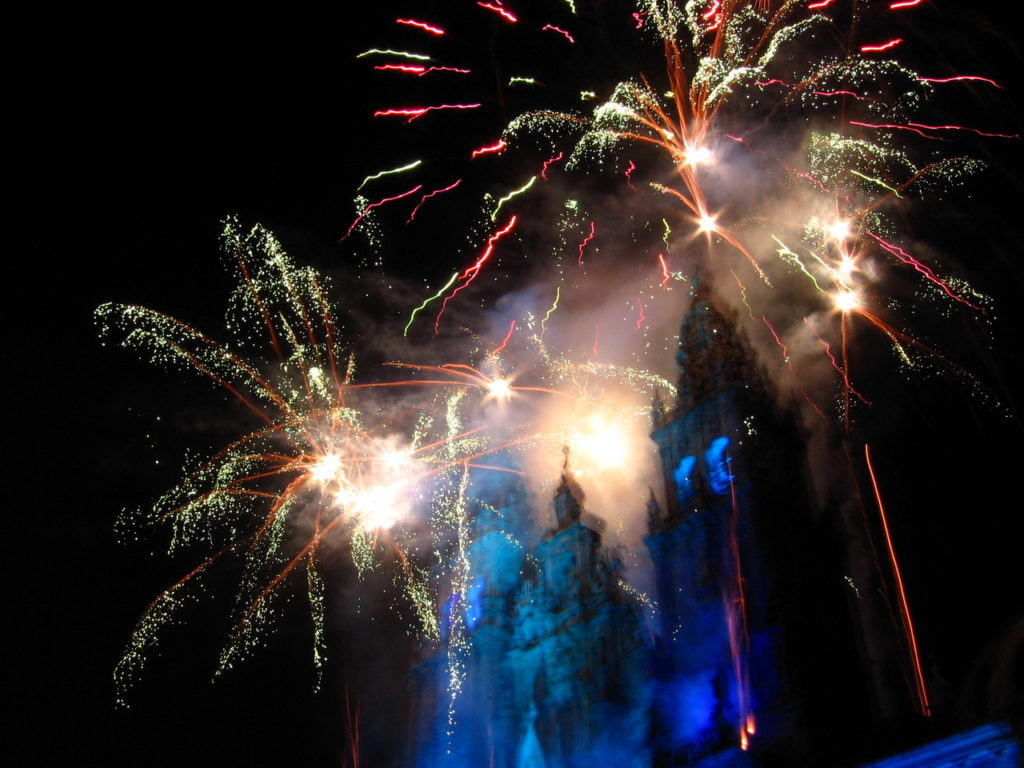
Photo: Henrique Pereira, CC BY-SA
Galicia and Spain
The effect of the holy years goes beyond Santiago. All of Spain and especially Galicia take advantage of the event! Various project tied to the jubilees are scheduled way before they even begin.
Jacobean holy years are a golden opportunity for everyone and at every level (local, regional, national, international). Culture, tourism, economy, relationships, to name just a few… everyone takes advantage of the event!
The prestige of Santiago, Galicia and Spain vastly increases; the benefits they all reap from the holy years are substantial and long-lasting, even after the jubilee is over.
It’s the best time for all of them to show themselves in their best light and catch the entire world’s eye. The resources dedicated to those ends are astronomical, particularly for the Camino. Huge grants are allotted to a large variety of projects by both the State and the regions; advertisement is meticulously designed far in advance; the event agenda is put together with great care. Nothing is left to chance!
It’s simply impossible to cover everything that’s going on during the Holy years, but here are some examples of the opportunities, projects and events the jubilees feed:
- Recognition, protection and enhancement of heritage assets
Of course, no one is waiting for holy years to take care of heritage assets but still. A special effort is made when a jubilee is coming. The most obvious example of that may be the renovation of the cathedral of Santiago, that was schedule to start after the holy year of 2010 and to be done by the one of 2021. Of course, many places and buildings also benefit from such preservation programs.
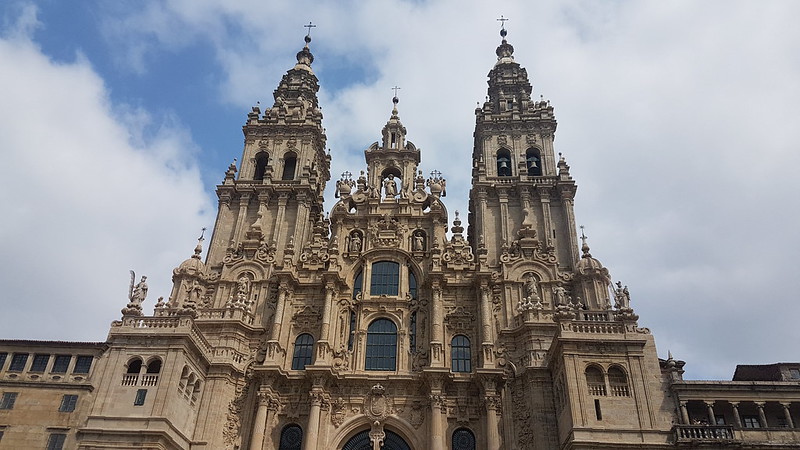
Source: landeicgn, Flickr, CC BY-NC-SA
- Improving infrastructures
The jubilees are usually the occasion to support the development of the Camino and its improvement. Many routes, albergues and information points were born or renovated in anticipation of holy years - Economic springboard and asset
There’s no denying it, Jacobean years generate an extraordinary economic activity. More than 350,000 pilgrims have been registered by the pilgrim office in 2019, while holy year attract about twice as many pilgrims than normal years… And this doesn’t take into account pilgrims who were not registered or tourists! The holy year is an obvious source of income, just as much for local family businesses as for larger companies who don’t miss the chance to use the jubilee as a sales pitch (have you ever had a “Jacobean Coke”?) - Cultural events
Art, literature, live performance, cinema, music, conferences… there’s something for everyone. In Santiago, in Galicia, everywhere in Spain! There’s no escaping a holy year! - Tourist promotion
“Spiritual capital of the world in 2021” (Santiago Tourism) or “Your Jubilee” (National Jacobean Council) are good examples of how the holy years are used to promote tourism. It becomes the must-see event of the year… - Inter-regional cooperation
It’s only logical, holy years are mostly celebrated in Santiago and in Galicia. However, more and more efforts are made to allow other Spanish regions to benefit from the event, mainly through the Caminos
Outside of Spain too!
The rest of the world is not left out! Although at a lesser scale, celebrations and events in relation with the holy years are held outside of Spain, mostly in the form of cultural events.
Let’s talk about it a bit later!
Holy years and Camino de Santiago
We’re already gone a long way and I bet you’re thinking something like, ok but what about the Camino??? I give you that we barely talked about it yet! But for a good reason: nowadays, Jacobean years and Caminos are not as tied together as we’d think.
At first glance, a great impact
You may have seen the statistics on the number of pilgrims per year? They look like this:
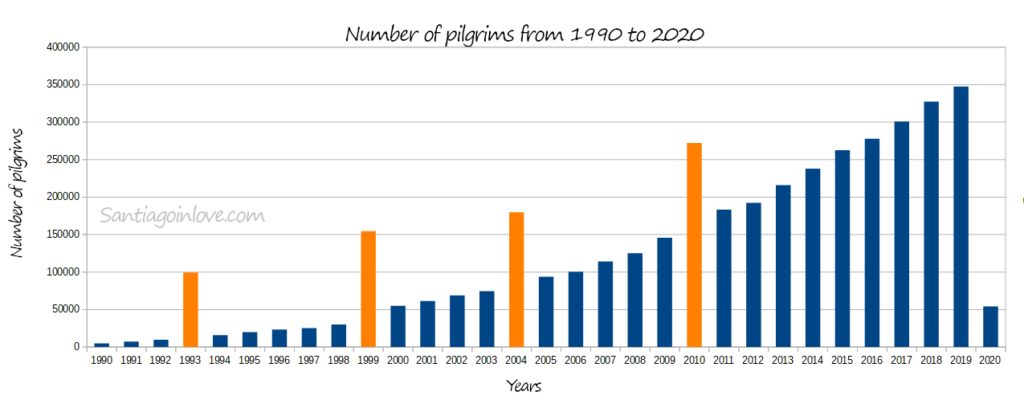
The number of pilgrims during the holy years is about the double or more compared to normal years!
With a closer look, surprise!
If you take the time to look beyond appearances, you’re on for a surprise… Unlike what the previous graph and pilgrim’s imagination lead us to believe, holy years have an overall effect on the Camino that is quite limited
Jubilees don’t need the Camino
We discussed it earlier, holy years have a meaning and requirements that are completely unrelated to the Camino
For those who want to gain plenary indulgences, no need to walk, pedal or ride. No need either to have your pilgrimage acknowledged by the pilgrim office; no need to get a Compostela!
The Camino don’t need the jubilees
Likewise, the Caminos evolved so that nowadays, they have a meaning of their own that doesn’t need religion
A growing number of pilgrims go to Santiago to experience the Camino, not to commune at the sanctuary. It’s not such a stretch to theorize that most of the pilgrims who got their Compostela have no wish to gain the jubilee.
Nearly as many pilgrims on the Camino
If we take a look at other statistics, it will give us a completely different idea about what’s going on on the Caminos during the holy years.
Let’s check the stats of the Pilgrim Office in Saint Jean Pied de Port:
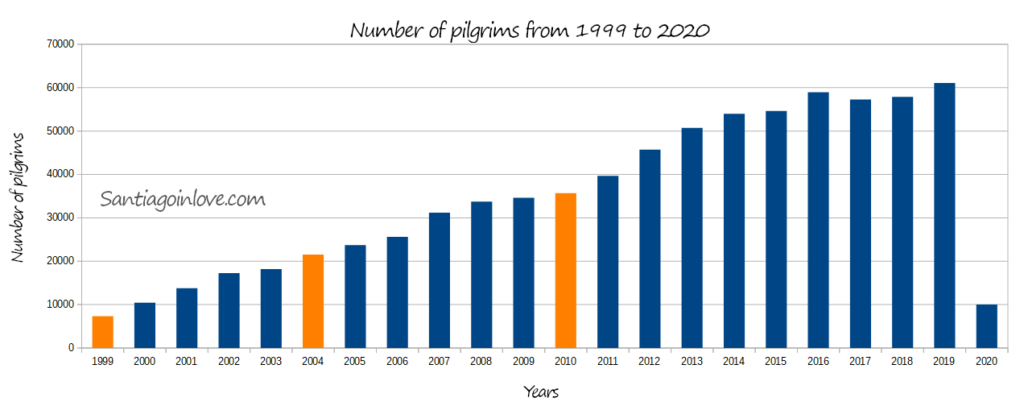
Even if Saint Jean is a major departure point for pilgrims, there are no exceptional changes in the number of pilgrims registered for the holy years. We can only note a slight increase, easily explained by the normal evolution of the pilgrimage that is more popular every year…
Dodging strategy
In contradiction with the statistics from Santiago, another reality among pilgrims. Many actually prefer to avoid going on the Camino during the holy years, by fear of having to deal with an overwhelming number of pilgrims…
The exception that proves the rule
If the Camino are not impacted by the holy years, where do the monstrous figures shared by the Pilgrim Office come from? The answer in a single word: Galicia!
Galicia, overrun with pilgrims
There are several reasons for that. First, Santiago is in Galicia and all Camino come together there. It’s only logical there are more pilgrims in the region.
Secondly and probably most importantly: the requirement to do the last 100km to be eligible for the Compostela. Whatever Camino pilgrims are walking, those last 100km will be in Galicia. Pilgrims who are interested in a minimal pilgrimage and receiving the certificate (and they are quite a lot!) will necessarily be in the region.
Let’s note that many organization choose the Camino to hold a variety of events. Associations, parishes, schools, travel agencies and many others chose Galicia to do a short Camino and allow participants to get a Compostela.
Finally, what better way to celebrate the holy year than with a pilgrimage to Santiago? If many pilgrims chose to avoid going that year, at least as many chose to go to Galicia to celebrate the jubilee, complete a short pilgrimage and get their Compostela.
In concrete terms, what does it mean?
We just said that overall, Jacobean years have little effect on the Caminos. Let’s now have a look on those effects and see how they impact pilgrims who choose to do a Camino during a holy year. Spoiler alert: the impact is mostly concentrated in Galicia and in Santiago!
- The Caminos are packed on the last 100km before Santiago
- It’s difficult too find a place to sleep on those same last 100km before Santiago
- There are lonnnnnnnnng waiting lines everywhere
- at the pilgrim office in Santiago, to get the Compostela. Even with their new online check-in system!
- to enter the cathedral through the holy door
- to enter the cathedral, even through another door…
- Difficulties to attend the Pilgrim Mass. It may even be impossible if you’re there for special events
- Difficulties to find a place to sleep in Santiago
- Difficulties to find a transport, for example if the end of your journey coincides with the end of the Festas
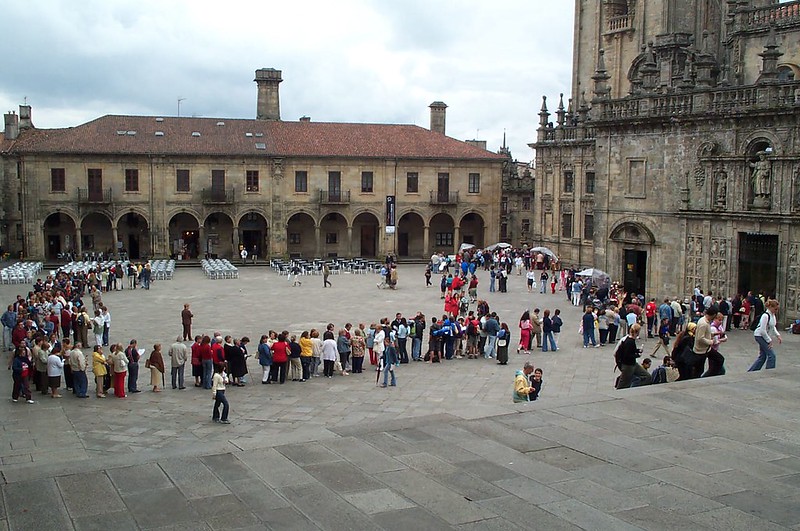
Photo: Alquiler de Coches, Flickr
Of course it also depends on the time of the year… Just like normal years, some times are more popular and so, busier than others.
Expect to take up a challenge during the holidays, the Semana Santa (Easter), in summer and around July 25th!
Solutions?
Avoid the craziest times of the year or be aware of them and plan accordingly to avoid bad surprises and stress. In any cases, arm yourself with patience and tolerance!
Some other effects
We’ve already talked about most of the effect of the holy years on the Camino. Let’s still check a couple of things!
Cultural events
We said it before, but it’s a fact: pilgrims will have more opportunities to enjoy a Camino-related event when it’s a jubilee year than during normal years
A festive credential
For the jubilees of 2010 and 2021, the cathedral created special commemorative credentials. Their look is different than normal ones and celebrate the event: a nice souvenir for pilgrims of the jubilee!
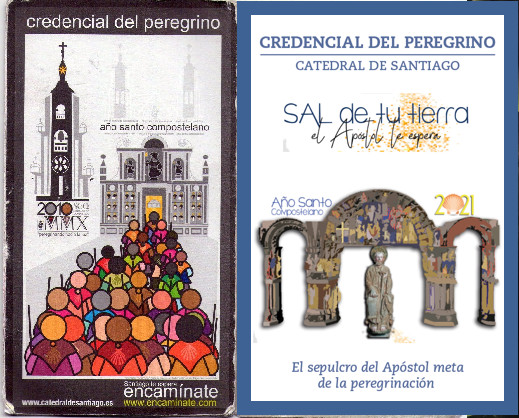
Right: credential for 2021
Compostela with a note
No special Compostela for the holy years, simply an additional note on the certificate. Another small souvenir for pilgrims of the jubilee.
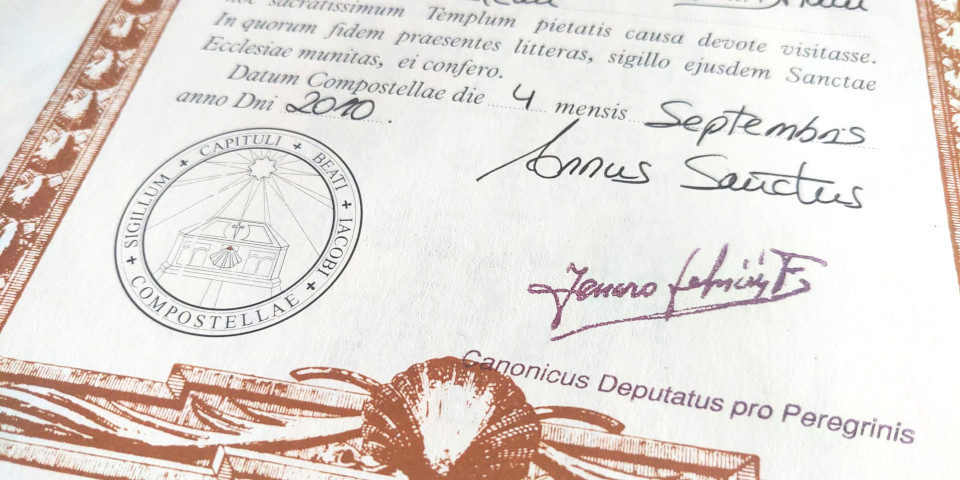
The holy year away from Santiago!
We came close to the topic a bit earlier: Jacobean years are events that are beyond Santiago! Let’s talk about other places that also celebrate the jubilee, sometimes quite far away from Spain.
Other “Jacobean indulgences”
The cathedral of Santiago isn’t the only place where you can receive plenary indulgences during Jacobean jubilees.
Remember, such jubilees are not celebrated anywhere or anyhow: they are tied to specific places and only granted by the Vatican. Jacobean years are intimately linked to the sanctuary and the cult to Saint James in Santiago. As such, it seems impossible other places could benefit of the same privileges… and yet!
Villafranca del Bierzo
You are on the Camino Francés but you’re to tired to complete your pilgrimage? No worries, you can gain your indulgences by stopping at about 200km from Santiago, in Villafranca del Bierzo!
Since its construction in the 12th century, the church of Saint James of the city has the same privileges for the Jacobean jubilees than the Santiago cathedral. The Vatican granted them to allow pilgrims to gain their plenary indulgences there if they were incapable to continue their pilgrimage until Santiago. The church also has a holy door, open and close in the same manner a the one in Santiago.
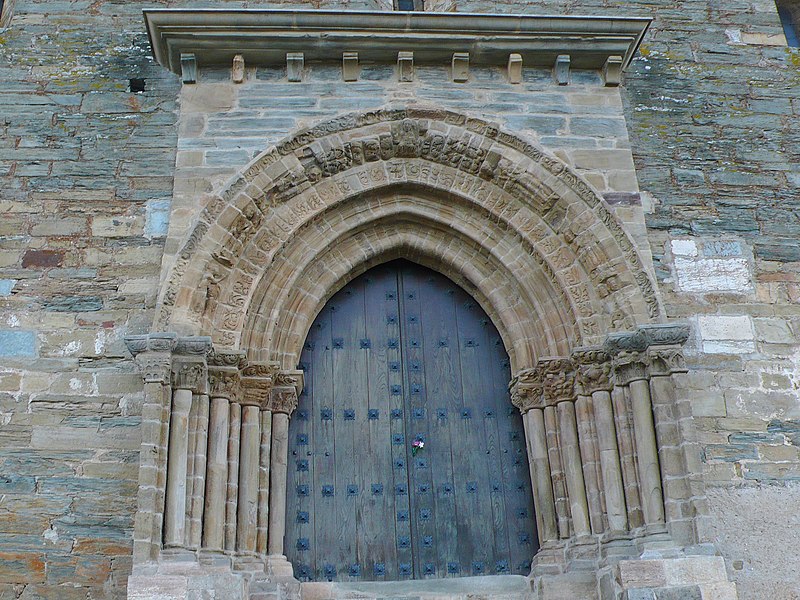
Photo: José Luis Filpo Cabana, CC BY
Gáldar
Interested in a tropical jubilee? 😉 Let’s head to the Canary islands and Gran Canarias! It may be far from Santiago, but we’re still in Spain… The Spanish conquest of the archipelago brought the cult of Saint James there, where it grew over the centuries. At the end of the 15th century, the church of Santiago de los Caballeros in Gáldar becomes the first Jacobean siege outside of Spain.
In recognition of that, the sanctuary received from the Vatican the exceptional authorization to celebrate the jubilee of 1965 and to grant the same plenary indulgences than the cathedral of Santiago. This authorization was renewed several times until it was granted in perpetuum in 1992. Since then, Galdar celebrates the jacobean holy years in the same way than Santiago. With there as well, the opening of its holy door.
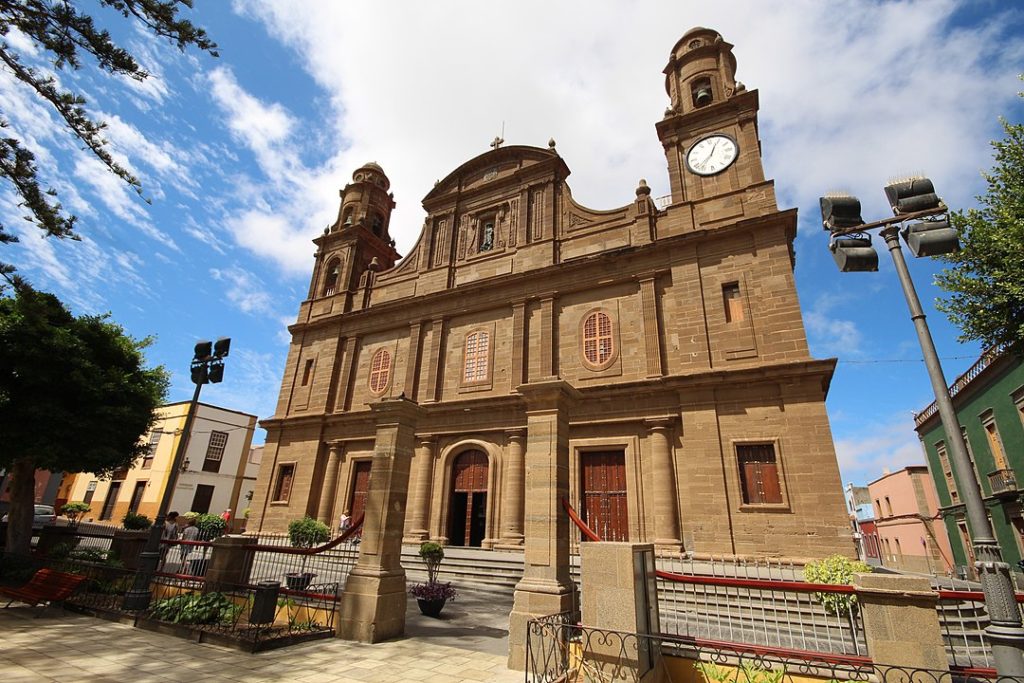
Photo: Victor R Ruiz, CC BY-SA
Pistoia, la Piccola Santiago
Rendezvous this time in the “Little Santiago”, at about 40km from Florence in Italy. Here, in the middle of Tuscany, Pistoia kept in close contact with Santiago since the Middle Ages. The city is also under the protection of San Jacopo (the Italian version of Saint James) and its cathedral is home of a fragment of the apostle’s relics, brought back from Santiago in the 12th century.
This strong Jacobean tradition led the Vatican to grant the sanctuary the authorization to celebrate the holy year of 2021, just like Santiago. For the occasion, the holy door of the cathedral was open and pilgrims who visit the sanctuary can gain the jubilee indulgences there.
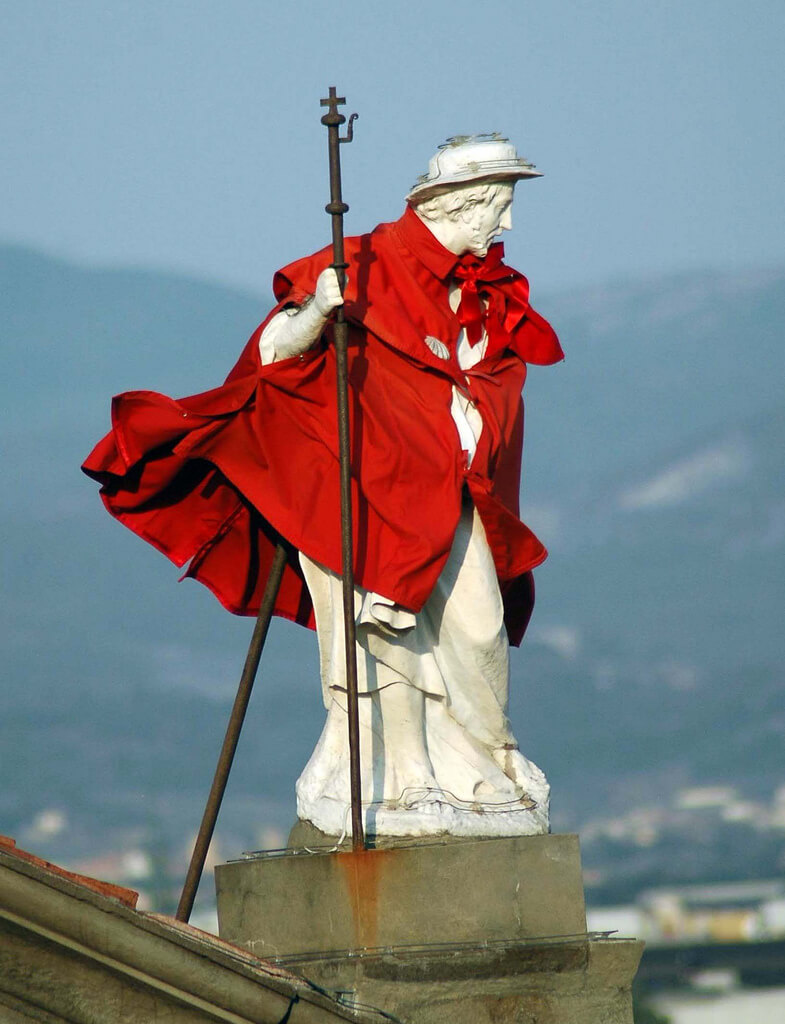
Photo: Diocesi di Pistoia
An event without borders
Diplomacy
The holy years are an opportunity to forge links and strengthen relations outside of Spain. The pope’s invitation to visit Santiago is a perfect example of that. It has a political dimension just as much as a religious one.
The presence of John Pal II in Santiago for the holy year of 1982 changed the course of the modern Jacobean history, by giving back to the sanctuary its international prestige. The speech he gave conveyed ideas that were later used by the young European Union, that used the pilgrimage to Santiago to unite, build and strengthen itself.
International events and cooperation
Of course, it also exist on normal years. But there are more events across various countries thanks to the holy years. In Portugal, France and other countries, many event are organized by Jacobean societies, or dioceses, or tourism offices along the Caminos.
On a larger scale, Spain and the rest of the world come together and collaborate for the jubilee. Many projects are carried out, by official institutions and local organizations alike. Demonstration in 3 examples!
The Spanish Guardia Civil collaborates with other European countries for the holy year of 2021. Foreign police representatives were sent to Spain and incorporated to the patrols deployed along the Camino, to help insure the safety of the routes and assist pilgrims in need.
The Alfombristas del Camino de Santiago (“flower carpet creators” on the Camino) sent out an international invitation to create alfombras to celebrate the holy year based on a suggested design. As I’m writing this post, more than 300 carpet have been created in over 25 différent countries!
On the initiative of the organization Europa Compostela, a join letter from the main European Jacobean societies was written and addressed to pilgrims. A way to celebrate the holy year despite the impossibility to organize a large join event…
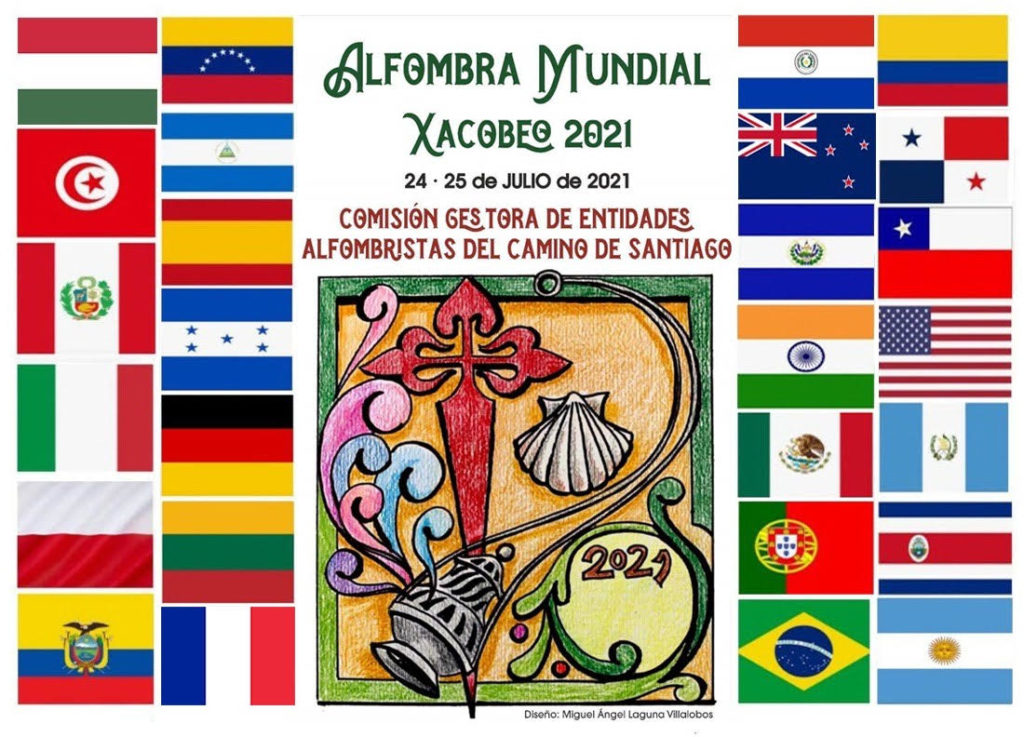
Here you are… You’re now an expert in Jacobean holy years! 😉 Congratulations to have made it to the end of this very long post! And now, it’s your turn to speak!
Have you ever done a pilgrimage during a holy year? Was it to gain the jubilee indulgences or “by chance”?
Have you ever walked through the holy door? What was your experience like for this special moment?
Do you have an experience, an anecdote to share with us?
Tell us in the comments! 🙂


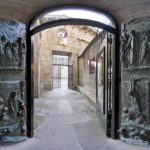
![[2016] Ending of the Jubilee of Mercy on the Camino [2016] Ending of the Jubilee of Mercy on the Camino](https://santiagoinlove.com/en/wp-content/uploads/sites/3/2016/11/Santiago-porte-sainte-fermee-150x150.jpg)
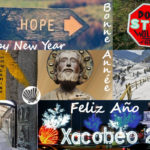
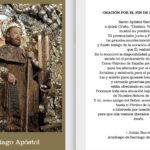
De Vlaamse Club voor Kunsten, Wetensschappen & Letteren uit Brussel (opgericht 1923) zal via Brabantica completa di Santiago, via Jacobskerk in Antwerpen (Rubens) en Brussel (Hertog Jan I van Brabant) aandoen in zijn pelgrimstocht om Rechtvaardige Rechters terugkeren te laten waar ze thuishoren, tevens zullen we een begin maken om 12 steentje die elk een Covid19 slachtoffer vertegenwoordigen op weg te verbinden met de Via Branantica. John Wubbe secretaris Vlaamse Club voor Kunsten, Wetenschappen & Letteren Visverkopersstraat Brussel.